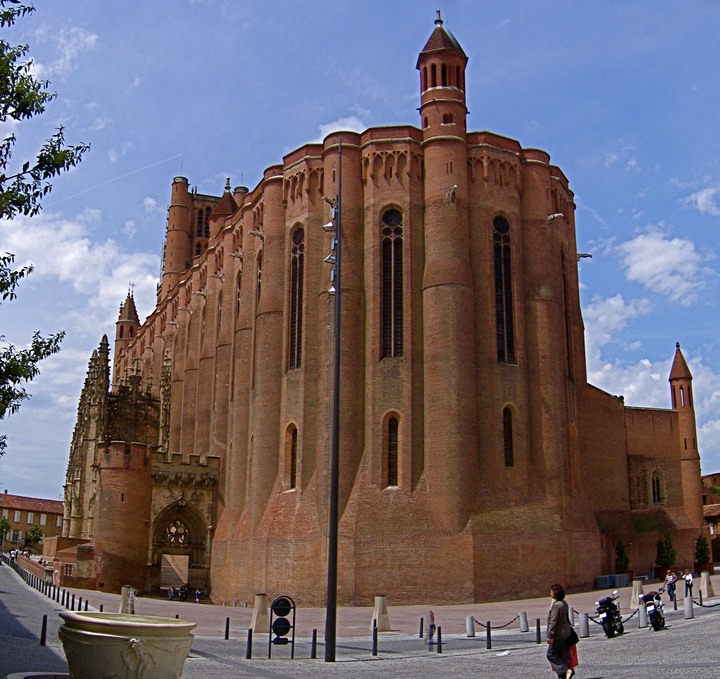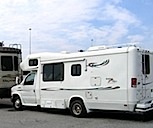Toulouse is called the “pink city” because many of its old city center buildings are made of brick that has a distinct pinky coral color. Thanks also to the wrought iron decorative railings and the tile roofs on many of the buildings, it is a beautiful city. We toured its old cathedral and a museum housed in an equally old monastery (the building was more interesting than much of the sculpture, art and artifacts inside). The sky was trying hard to rain, but it wasn’t so bad that we couldn’t stop at an outdoor restaurant and have crepes for lunch (under a big awning.) Afterwards, there was an unusual collectors toy and book market in the city square, where people were lined up to get in. We didn’t see anything special in any of it. On the other side of the large ornate government building on the square is the Wilson Place, a lovely little garden park in the middle of a traffic circle. We are still trying to figure out who “President Thomas Wilson” was--that was the name on every plaque in the area.
After two nights in Toulouse we drove to Albi, a town we’d never heard of--we were relying on the guide book’s high recommendation. We found a campground close to the city center and--we could hardly believe it--right next to not one but two grocery stores, despite its quiet, green park-like setting. It was about a half hour walk to the center of Albi, which turned out to be a great delight: large clean open plazas with fountains and lots of people. And the sunshine probably helped, too.
Of the places we’d known nothing about before seeing them, the cathedral at Albi has been the most impressive so far. The Lonely Planet guide does a great job of introducing it: in the south of medieval France, a group called the Cathars believed some heretical things (the Albigensian heresies); one of these--their big mistake--was a rejection of worldly Rome; the Pope took offense and preached a Crusade against them; so between 1208 and 1321 thousands of them were killed by the armies of princes from northern France, who were happy to expand their influence southward with the Church’s blessing; and in the newly conquered territories the invaders erected huge new churches “to impress and subdue.”
One of these was the Cathedral Ste-Cecile at Albi, and its exterior certainly does make a threatening statement.

Lonely Planet: “Its sheer mass rises over town like some Tolkienesque dark lord’s tower.”
But that effect is only half the story: when you step inside, the contrast with the sinister exterior is amazing. In the early 1500s a whole troupe of Italian Renaissance artists had descended on the place, not leaving until they had painted the entire interior, one chapel after another . . . and, of course, the ceiling, too.

And if that’s not enough, Ste. Cecilia herself looks like a Pre-Raphaelite maiden:

Walking back to the city square in Albi, we stopped at a sports bar to watch the end of the first stage of the Giro d'Italia, the three-week bike race around Italy. We were told, with some heat, that no bar in town would tune in to such a thing on a day when Toulouse was playing an important Rugby League match (not soccer, mind you: rugby).
On Sunday we drove to Carcassonne and spent the afternoon doing laundry and hoping it wouldn’t rain. The drive had been a little scary because of very strong winds, but this time the red roads on the maps turned out to be very good ones, which helped somewhat.
The campground in Carcassonne is a short walk from the walled medieval city. At night the walls are illuminated, and we can see them from Rover. It looks like a fairy tale setting. In the morning we made an easy walk along a pretty little creek to the city. The old fortress which was originally the city is completely surrounded by walls and turreted towers, with access through only three gates. One of them even has a drawbridge. But when we finally got to the front gate, the first thing we saw was a car coming out the drawbridge entrance!


A new city has grown up around the old walled one, which has become totally a tourist trap--but a very lovely one. Its beginnings date back to the 12th century. Much was added to the fortifications in the 16th and 17th centuries, and major restoration work was done in the mid 1800’s while retaining the 17th century style. We toured the castle and walked every street. Every second building is a cafe or restaurant, and the ones between them are souvenir shops. But it was all still quite charming, even in the wind, which has remained strong.
It’s interesting that although we have been in many incredible places of worship, and quite a few simple ones, too, we have been unable to go to a church service. Like good ecumenical Lutherans, we’d not even insist that it be a Protestant service, but no dice. In fact, we didn’t even see a Protestant church until we’d arrived in Toulouse, but even that one didn’t list a worship schedule. In fact, only the big cathedrals have had a schedule that is regular: the small ones we’ve been near haven’t had services while we are around.
This campground in Carcassonne has free unlimited internet access so we were finally able to update this blog. Every McDonalds in France seems to have free WiFi, and we rely on them for our everyday email, baseball scores and news, but half the time the connection in the restaurant won’t let us publish our blog. And since we do not carry the computer with us all the time, we sometimes have a hard time finding a place that will let us upload.
In this campground we met a man from Denmark who spent six months riding his motorcycle around 28 US states. He got there by riding it across Russia, Siberia, and Mongolia before shipping it from Korea to British Columbia. Then he rode up to Alaska before coming back down to the rest of the US. Right now he is walking through France with a tent on his back. And people think we are adventurous!
